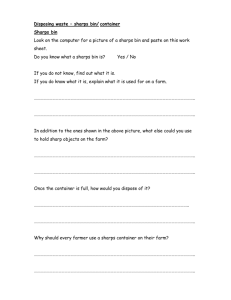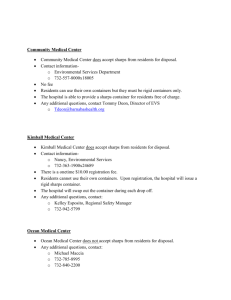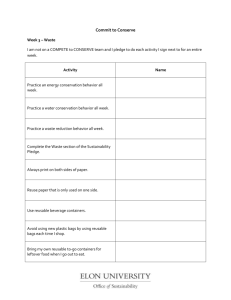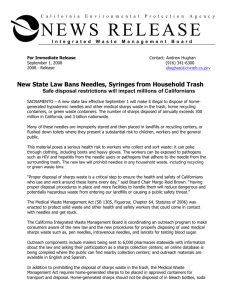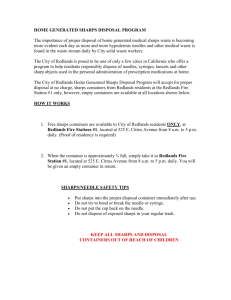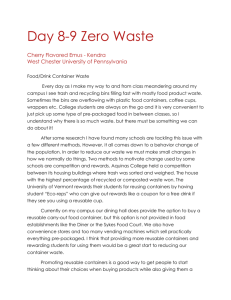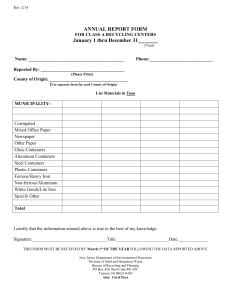Reusable Sharps Container Pilot Project
advertisement
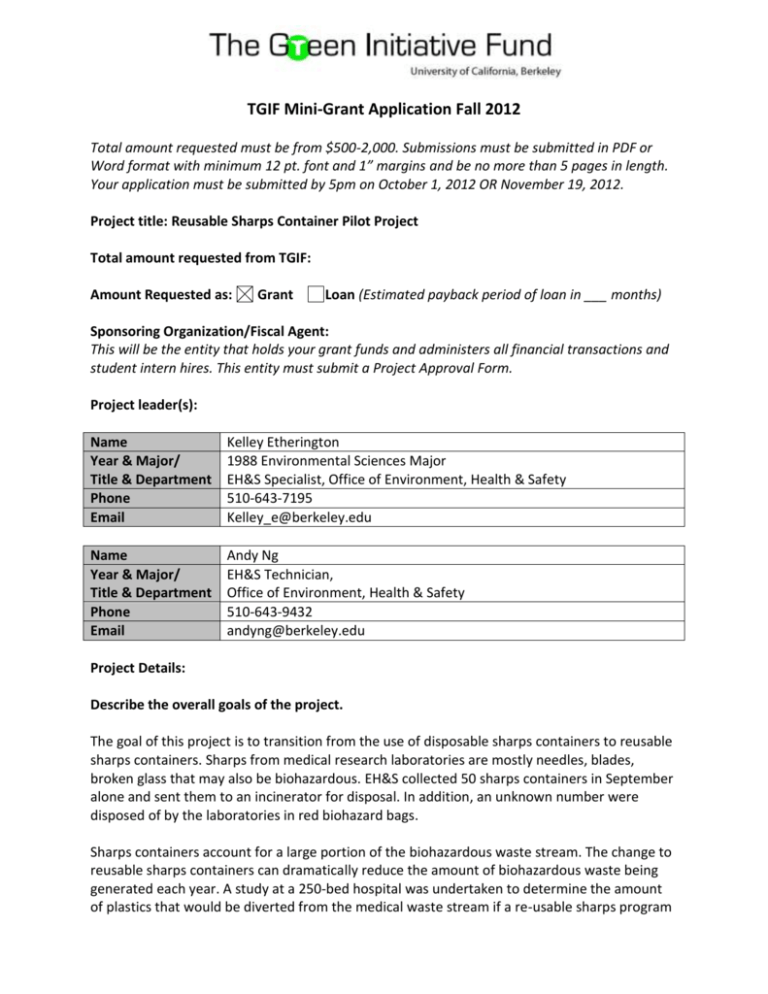
TGIF Mini-Grant Application Fall 2012 Total amount requested must be from $500-2,000. Submissions must be submitted in PDF or Word format with minimum 12 pt. font and 1” margins and be no more than 5 pages in length. Your application must be submitted by 5pm on October 1, 2012 OR November 19, 2012. Project title: Reusable Sharps Container Pilot Project Total amount requested from TGIF: Amount Requested as: Grant Loan (Estimated payback period of loan in ___ months) Sponsoring Organization/Fiscal Agent: This will be the entity that holds your grant funds and administers all financial transactions and student intern hires. This entity must submit a Project Approval Form. Project leader(s): Name Year & Major/ Title & Department Phone Email Kelley Etherington 1988 Environmental Sciences Major EH&S Specialist, Office of Environment, Health & Safety 510-643-7195 Kelley_e@berkeley.edu Name Year & Major/ Title & Department Phone Email Andy Ng EH&S Technician, Office of Environment, Health & Safety 510-643-9432 andyng@berkeley.edu Project Details: Describe the overall goals of the project. The goal of this project is to transition from the use of disposable sharps containers to reusable sharps containers. Sharps from medical research laboratories are mostly needles, blades, broken glass that may also be biohazardous. EH&S collected 50 sharps containers in September alone and sent them to an incinerator for disposal. In addition, an unknown number were disposed of by the laboratories in red biohazard bags. Sharps containers account for a large portion of the biohazardous waste stream. The change to reusable sharps containers can dramatically reduce the amount of biohazardous waste being generated each year. A study at a 250-bed hospital was undertaken to determine the amount of plastics that would be diverted from the medical waste stream if a re-usable sharps program were implemented. The containers were weighed empty and the weights recorded and then multiplied by the numbers of containers used each year. The result indicated that 13 tons of biohazardous waste could be diverted from the hospital annually by implementing a reusable sharps container program.1 Having readily available, reusable sharps containers on hand will instigate collaboration and planning among staff to offer this service to campus and reduce the amount of waste going to incinerators and landfills. It will also reduce the number of single-use, plastic sharps containers purchased by laboratories. This pilot project help EH&S better understand laboratories’ needs, it will reduce their costs of purchasing single use containers and prevent plastic from entering the solid waste stream. Biohazardous Waste Mixed with Sharps Containers Finally, this pilot project seeks to understand the cost benefits of providing reusable sharps containers to laboratories. Since there is a labor cost involved for EH&S we will determine the affordability of the program. If the pilot proves successful, we can approach University Health Services and other departments to participate in the reuse program on a larger scale. How will the project be implemented? Describe the steps. EH&S will purchase about 100 reusable sharps containers of varying sizes. When a lab makes a request for EH&S to pick up a full sharps container, we will drop off a free, empty container for every full container collected. (This is similar to the current battery recycling program.) Our technicians will also drop off a flyer to publicize the service, give credit to TGIF for funding it, and request feedback from the lab. A short survey will be created and we will enter each survey participant into a drawing to receive a $50 gift card to the Cal Student Store. We will also hire a student to help track and document the sustainability metrics, create the flyer and survey and complete progress reports. 1 Greening of the Red-Bag Waste Stream: A Guidance Document for Successful Interventions to Reduce Medical Waste Generation in California Hospitals, Jack McGurk, Chief, Environmental Management Branch, California Department of Health Services, February 2004 The vendor will transport the full, reusable containers to their facility, use a robotic system to safely empty and sterilize the containers, and return the empties to EH&S. EH&S will redistribute as requests for pickups come in. Which aspects or campus sustainability will your project tackle? What are the quantitative and/or qualitative sustainability metrics? This project can make a major waste minimization impact on campus and will be simple to implement. Once successful and the process is ironed out, we will tackle University Health Service, and the biological sciences labs in the long term. We have records of current disposal volumes for sharps containers processed through our hazmat facility (over 2,700 pounds and 493 sharps containers in the past year). The weight of the sharps containers that are reused will be weighed and that will be the number of pounds that we prevented from going to incineration or landfill. The cost of the container that no longer has to be purchased by the laboratories is approximately $10 to $20 each. The qualitative sustainability metrics include reductions in: the manufacturing of new containers from virgin petroleum resin, pollution, greenhouse gas emissions and energy usage. How will you measure the sustainability and environmental benefits? We will measure how many pounds of single-use, plastic sharps containers are no longer being purchased and how many are being diverted from the solid waste stream. The program is economical too. Purchasing and disposing of a 3-gallon sharps container currently costs a lab about $20. After the free pilot project ends, the total cost of purchasing a reusable sharps container and disposing of the contents is approximately $15. In one year the savings to campus could exceed $2,500. What is your plan for publicizing your project? Do you have any specific outreach goals? We will ask laboratories to participate but the effort on their part will be minimal. Our technicians will drop off a flyer to publicize the service, give credit to TGIF for funding it, and request feedback from the lab. A short survey will be created and we will enter each survey participant into a drawing to receive a $50 gift card to the Cal Student Store. We will publicize the sustainability metrics in the EH&S Annual Report and the Berkeleyan. Project Approvals Needed: If your project team is partnering with other organizations, or departments, or needs permission to undertake a specific project, please submit a completed Project Approval Form for each named entity. For the pilot project EH&S will not have to partner with other departments. Budget: List all budget items for which funding is being requested under the appropriate category. Include cost/item and total amount/item requested. Please be as detailed as possible. Item Cost per Item Quantity Total Request 2 –gallon reusable sharps containers (6 per box) 3-gallon reusable sharps containers (6 per box) $55 $55 7 7 $385 $385 4-gallon reusable sharps containers (4 per box) $55 7 $385 $50 gift card for survey participation drawing $50 1 $50 Personnel and Wages Student intern to track waste diversion, write progress reports, deliver sharps containers $12 60 $720 Equipment and Construction Costs Publicity and Communication General Supplies and Other TOTAL $1,925 If selected by TGIF, your project must be completed by May 31, 2012. (2013??) Please email completed abstracts to tgif_grants@berkeley.edu and put the name of your project in the subject line. Questions and comments may be directed to TGIF Coordinator, Katherine Walsh, at tgif_info@berkeley.edu /510-643-2992.

